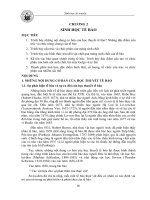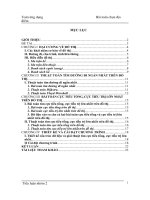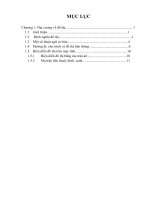Tin học ứng dụng trong công nghệ hóa học Distributedsystem 16 fileservice
Bạn đang xem bản rút gọn của tài liệu. Xem và tải ngay bản đầy đủ của tài liệu tại đây (609.47 KB, 28 trang )
Teaching material
based on Distributed
Systems: Concepts
and Design, Edition 3,
Addison-Wesley 2001.
Distributed Systems Course
Distributed File Systems
Copyright © George
Coulouris, Jean Dollimore,
Tim Kindberg 2001
email:
This material is made
available for private study
and for direct use by
individual teachers.
It may not be included in any
product or employed in any
service without the written
permission of the authors.
Viewing: These slides
must be viewed in
slide show mode.
Chapter 2 Revision: Failure model
Chapter 8:
8.1
8.2
8.3
[8.4
8.5
8.6
Introduction
File service architecture
Sun Network File System (NFS)
Andrew File System (personal study)]
Recent advances
Summary
Learning objectives
Understand the requirements that affect the design
of distributed services
NFS: understand how a relatively simple, widelyused service is designed
–
–
–
–
Obtain a knowledge of file systems, both local and networked
Caching as an essential design technique
Remote interfaces are not the same as APIs
Security requires special consideration
Recent advances: appreciate the ongoing research
that often leads to major advances
2
Chapter 2 Revision: Failure model
Figure 2.11
Class of failure
Fail-stop
Affects
Process
Description
Process halts and remains halted. Other processes may
detect this state.
Crash
Process Process halts and remains halted. Other processes may
not be able to detect this state.
Omission
Channel A message inserted in an outgoing message buffer never
arrives at the other end’s incoming message buffer.
Send-omission Process A process completes a send, but the message is not put
in its outgoing message buffer.
Receive-omission Process A message is put in a process’s incoming message
buffer, but that process does not receive it.
Arbitrary
Process Process/channel exhibits arbitrary behaviour: it may
(Byzantine)
or channel send/transmit arbitrary messages at arbitrary times,
commit omissions; a process may stop or take an
incorrect step.
3
Storage systems and their properties
In first generation of distributed systems (1974-95),
file systems (e.g. NFS) were the only networked
storage systems.
With the advent of distributed object systems
(CORBA, Java) and the web, the picture has
become more complex.
4
Storage systems and their properties
Figure 8.1
Types of consistency between copies: 1 - strict one-copy consistency
√ - approximate consistency
X - no automatic consistency
Sharing Persis- Distributed
Consistency Example
tence
cache/replicas maintenance
Main memory
1
RAM
File system
1
UNIX file system
Distributed file system
Sun NFS
Web
Web server
Distributed shared memory
Ivy (Ch. 16)
Remote objects (RMI/ORB)
1
CORBA
Persistent object store
1
CORBA Persistent
Object Service
Persistent distributed object store
PerDiS, Khazana
5
What is a file system?
1
Persistent stored data sets
Hierarchic name space visible to all processes
API with the following characteristics:
– access and update operations on persistently stored data sets
– Sequential access model (with additional random facilities)
Sharing of data between users, with access control
Concurrent access:
– certainly for read-only access
– what about updates?
Other features:
– mountable file stores
– more? ...
6
*
What is a file system?
2
Figure 8.4 UNIX file system operations
filedes = open(name, mode)
filedes = creat(name, mode)
status = close(filedes)
count = read(filedes, buffer, n)
count = write(filedes, buffer, n)
pos = lseek(filedes, offset,
whence)
status = unlink(name)
status = link(name1, name2)
status = stat(name, buffer)
Opens an existing file with the given name.
Creates a new file with the given name.
Both operations deliver a file descriptor referencing the open
file. The mode is read, write or both.
Closes the open file filedes.
Transfers n bytes from the file referenced by filedes to buffer.
Transfers n bytes to the file referenced by filedes from buffer.
Both operations deliver the number of bytes actually transferred
and advance the read-write pointer.
Moves the read-write pointer to offset (relative or absolute,
depending on whence).
Removes the file name from the directory structure. If the file
has no other names, it is deleted.
Adds a new name (name2) for a file (name1).
Gets the file attributes for file name into buffer.
7
*
What is a file system?
4
Figure 8.3 File attribute record structure
updated
by system:
File length
Creation timestamp
Read timestamp
Write timestamp
Attribute timestamp
Reference count
Owner
updated
by owner:
File type
Access control list
E.g. for UNIX: rw-rw-r-9
*
File service requirements
Transparency
Concurrency
Replication
Heterogeneity
Fault tolerance
Consistency
Security
Efficiency..
Tranparencies
Concurrency
properties
Replication
properties
Heterogeneity
Access:
Sameproperties
operations
Fault
tolerance
Consistency
Isolation
Security
File
service
maintains
multiple
identical
copies
of
Efficiency
Service
can
be
accessed
by
clients
running
on
Location:
Same
name
space
after
relocation
of
Service
must
continue
tocontrol
operate
even
when
Unix
offers
one-copy
update
semantics
for asclients
File-level
or
record-level
locking
files
Must
maintain
access
and
privacy
(almost)
any
OS
or hardware
platform.
Goal
for
distributed
file systems
is usually for
files
or
processes
make
errors
or
crash.
operations
on local files - caching is completely
local
files.
Other
forms
of
concurrency
control
to
minimise
•
Load-sharing
between
servers
makes
service
performance
comparable
tothe
local
file
system.
Design
must
be
compatible
with
file
systems
of
Mobility:
Automatic
relocation
of
files
is
possible
transparent.
•more
at-most-once
semantics
•based
on identity of user making request
contention
scalable
different
OSes
Performance:
Satisfactory
performance
across a
Difficult
to
achieve
the
same
for
distributed
file
•
at-least-once
semantics
•identities
of
remote
users must
be authenticated
• Service
Local access
has
better
response
(lower
latency)
specified
rangebe
of open
system
loads
interfaces
must
- precise
systems
while
maintaining
good
performance
•requires
idempotent
operations
•privacy
requires
secure
communication
• Fault
specifications
APIs
published.
Scaling:
Service of
can
be are
expanded
to meet
andtolerance
scalability.
Service must
resume
after
a server
machine not
interfaces
are
open
to all processes
additional
loads
FullService
replication
is difficult
to
implement.
crashes.
excluded by a firewall.
Caching (of all or part of a file) gives most of the
If the service
is replicated,
it can continue
impersonation
andto
other
benefits •vulnerable
(except faulttotolerance)
operate
even during a server crash.
attacks
10
*
Model file service architecture
Figure 8.5
Client computer
Lookup
AddName
UnName
GetNames
Server computer
Directory service
Application Application
program
program
Flat file service
Client module
Read
Write
Create
Delete
GetAttributes
SetAttributes
11
Server operations for the model file service
Figures 8.6 and 8.7
Flat file service
Directory service
position of first byte
Read(FileId, i, n) -> Data
position of first byte
Write(FileId, i, Data)
Create() -> FileId
Delete(FileId)
GetAttributes(FileId) -> Attr
SetAttributes(FileId, Attr)
Lookup(Dir, Name) -> FileId
FileId
AddName(Dir, Name, File)
UnName(Dir, Name)
GetNames(Dir, Pattern) -> NameSeq
Pathname lookup
FileId
Pathnames
such as '/usr/bin/tar' are resolved
Aby
unique
identifier
anywhere
thefor
iterative
callsfor
to files
lookup(),
oneincall
network.
each component of the path, starting with
the ID of the root directory '/' which is
known in every client.
12
*
File Group
A collection of files that can be
located on any server or moved
between servers while
maintaining the same names.
– Similar to a UNIX filesystem
– Helps with distributing the load of file
serving between several servers.
– File groups have identifiers which are
unique throughout the system (and
hence for an open system, they must
be globally unique).
Used to refer to file groups and files
13
To construct a globally unique
ID we use some unique
attribute of the machine on
which it is created, e.g. IP
number, even though the file
group may move subsequently.
File Group ID:
32 bits
IP address
16 bits
date
*
Case Study: Sun NFS
An industry standard for file sharing on local networks since the 1980s
An open standard with clear and simple interfaces
Closely follows the abstract file service model defined above
Supports many of the design requirements already mentioned:
–
–
–
–
transparency
heterogeneity
efficiency
fault tolerance
Limited achievement of:
–
–
–
–
concurrency
replication
consistency
security
14
*
NFS architecture
Client computer
Figure 8.8
NFS
Application
program Client
Client computer
Application Application
program
program
Server computer
Application
program
Kernel
UNIX
system calls
Virtual file system
Operations
on local files
UNIX
file
system
Other
file system
UNIX kernel
Operations
on
remote files
NFS
client
Virtual file system
NFS
server
NFS
Client
UNIX
file
system
NFS
protocol
(remote operations)
15
*
NFS architecture:
does the implementation have to be in the system kernel?
No:
– there are examples of NFS clients and servers that run at applicationlevel as libraries or processes (e.g. early Windows and MacOS
implementations, current PocketPC, etc.)
But, for a Unix implementation there are advantages:
– Binary code compatible - no need to recompile applications
Standard system calls that access remote files can be routed through the
NFS client module by the kernel
– Shared cache of recently-used blocks at client
– Kernel-level server can access i-nodes and file blocks directly
but a privileged (root) application program could do almost the same.
– Security of the encryption key used for authentication.
16
*
NFS server operations (simplified)
Figure 8.9
•
•
•
•
•
•
•
•
•
•
•
•
•
•
•
fh = fileModel
handle:flat file service
read(fh, offset, count) -> attr, data
Read(FileId, i, n) -> Data
write(fh, offset, count, data) -> attr
identifier i-node
number i-node generation
Write(FileId,
i, Data)
create(dirfh, name, attr) -> newfh, attr Filesystem
Create() -> FileId
remove(dirfh, name) status
Delete(FileId)
getattr(fh) -> attr
GetAttributes(FileId) -> Attr
setattr(fh, attr) -> attr
SetAttributes(FileId, Attr)
lookup(dirfh, name) -> fh, attr
rename(dirfh, name, todirfh, toname)
Model directory service
link(newdirfh, newname, dirfh, name)
Lookup(Dir, Name) -> FileId
readdir(dirfh, cookie, count) -> entries
AddName(Dir, Name, File)
symlink(newdirfh, newname, string) -> statusUnName(Dir, Name)
readlink(fh) -> string
GetNames(Dir, Pattern)
mkdir(dirfh, name, attr) -> newfh, attr
->NameSeq
rmdir(dirfh, name) -> status
statfs(fh) -> fsstats
17
*
NFS access control and authentication
Stateless server, so the user's identity and access rights must
be checked by the server on each request.
– In the local file system they are checked only on open()
Every client request is accompanied by the userID and groupID
– not shown in the Figure 8.9 because they are inserted by the RPC system
Server is exposed to imposter attacks unless the userID and
groupID are protected by encryption
Kerberos has been integrated with NFS to provide a stronger
and more comprehensive security solution
– Kerberos is described in Chapter 7. Integration of NFS with Kerberos is covered
later in this chapter.
18
*
Mount service
Mount operation:
mount(remotehost, remotedirectory, localdirectory)
Server maintains a table of clients who have
mounted filesystems at that server
Each client maintains a table of mounted file
systems holding:
< IP address, port number, file handle>
Hard versus soft mounts
19
*
Local and remote file systems accessible on an NFS client
Figure 8.10
Server 1
Client
(root)
(root)
export
...
(root)
usr
nfs
Remote
people
big jon bob
vmunix
Server 2
mount
Remote
students
x
...
staff
mount
users
jim ann jane joe
Note: The file system mounted at /usr/students in the client is actually the sub-tree located at /export/people in Server 1;
the file system mounted at /usr/staff in the client is actually the sub-tree located at /nfs/users in Server 2.
20
*
NFS optimization - server caching
Similar to UNIX file caching for local files:
– pages (blocks) from disk are held in a main memory buffer cache until the space
is required for newer pages. Read-ahead and delayed-write optimizations.
– For local files, writes are deferred to next sync event (30 second intervals)
– Works well in local context, where files are always accessed through the local
cache, but in the remote case it doesn't offer necessary synchronization
guarantees to clients.
NFS v3 servers offers two strategies for updating the disk:
– write-through - altered pages are written to disk as soon as they are received at
the server. When a write() RPC returns, the NFS client knows that the page is
on the disk.
– delayed commit - pages are held only in the cache until a commit() call is
received for the relevant file. This is the default mode used by NFS v3 clients. A
commit() is issued by the client whenever a file is closed.
23
*









